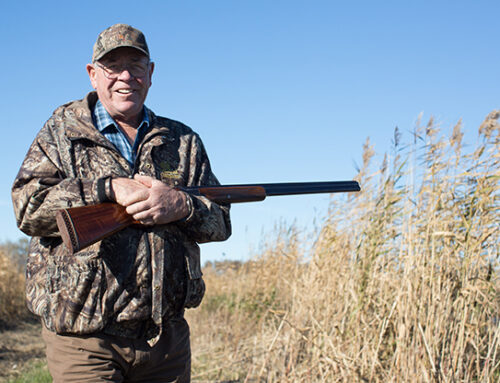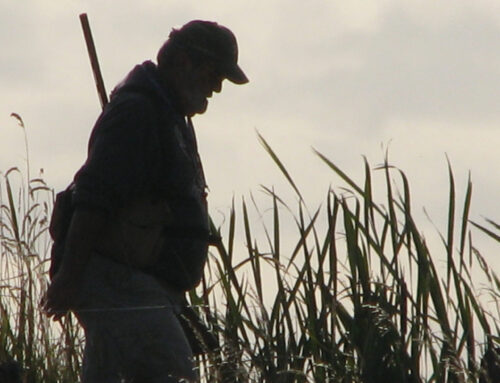The Tin Can

A discovery sparks memories of bygone waterfowlers’ country boy ingenuity
By Bill Miller
A while back, I was ransacking the garage in search of a socket wrench I last recalled using to tighten the hitch on my decoy trailer. That’s when, on a shelf next to the cluttered workbench, I rediscovered a rusted tin can. On came an instant nostalgia head rush.
To most, the rusting can would be the literal definition of rubbish. There are piles of its clones rusting into oblivion around sloughs and on lakeshores in a small region of Wisconsin, and likely nowhere else. They must have been discovered many times by hunters, ’shroomers, and other sorts who poke around the woods. The cans are so ordinary, I’ll bet even a certified, book-smart, Ph.D. archaeologist would toss one aside with a dismissive “junk.” However, I’m likely the last of a couple dozen humans alive to whom the tin can held significance.
The can is a portal through time and around the detritus of life back to hunting days with my father and his buddies. They were country boys — raised before television, without an inkling of the internet, and mostly without indoor plumbing — but these guys were geniuses.
Let me describe the rusted can, and see if you can figure out its waterfowling purpose.
It’s a No. 10 — that’s the size of a large coffee can. (Yes, coffee used to come in cans, not Starbucks cups.) It was sealed on both ends and remains so. The can was “opened” not with a crank-the-handle opener or a P-38, but by piercing with equilateral triangular holes. Mind you, not through the lid like you’d open a can of tomato juice to wash a skunked dog, but through the sidewall just below the rims on each end. This was done with the pointy end of a church key opener. After years of scrubbing by rain, wind and sun — and 70-plus winters buried in snow — there’s no trace revealing what the can contained.
Any guesses?
Of the can itself, there’s not much more to describe, but if you located one of the piles of cans and did some searching, nearby you might find another artifact to give you a clue. By now, all that would likely remain would be a concrete disc, 14 to 16 inches across and two inches thick. Maybe there’d be skeletal, rusted remains of a 5-gallon steel paint bucket or grease pail. The concrete disc was sized to nestle securely atop those tall pails.
In its day, the pail was pretty much as it came from the factory, except the original lid was pried off and discarded; the residual contents carefully scrubbed or burned out. Just up from the base, on one side, there was a hole about 2×2 inches. A small door was fashioned to either slide or swing over the opening allowing adjustment — completely closed to completely open.
Still need to phone a friend? The little door was a vent. That should give it away.
Most of Pa’s buds worked at a canning company. As such, they could “can” anything they wanted on break or after the closing whistle. It’s lost to the annals of Waldo Gang Camp lore exactly which guy came up with the idea, but they all contributed refinements over the years.
In a No. 10 tin they’d can a double handful of charcoal briquettes along with a generous squirt of starter fluid. Each one would tote a can to the blind. At each blind, there was at least one, often two of the 5-gallon-pail-with-concrete-lid setups, each with a church key wired to it.
While one guy waded out to set the decoys, the other would punch holes around the top and bottom of the cans, then use his lighter to ignite the starter fluid. With flames shooting out of the top and bottom of the cans, he’d juggle them into the pails and place the concrete lids on top. Adjusting the vent controlled the burn.
In minutes the concrete disc became a pleasantly warm seat. Lay a wool blanket across the lap and … voila … the original seat heater!
But the genius didn’t end there. After hours of shooting, a guy would get hungry. Would they settle for cold ham and Wisconsin cheddar cheese sandwiches? Certainly not! Why slum it when they could enjoy toasted hard rolls with frizzled ham and steaming melted cheese to warm their innards?
All that need be done was to remove the cement lid and toast the sandwich right there on the still-plenty-hot top of the No. 10 tin. Toasted buns all morning, and toasted buns for lunch!
Holding this rusting tin can in my hand reminds me I am the progeny of geniuses — and also makes me wonder what the heck happened to me.
Because apparently, I’m not even smart enough to avoid laying a blasted socket wrench on the bumper of my truck and leaving it there as I drive away.






Oh the memories of hunting with grandpa